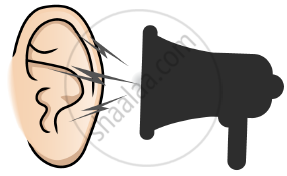Advertisements
Advertisements
प्रश्न
Given in the box below are a set of 14 biological terms. Of these, 12 can be paired into 6 matching pairs. Out of the six pairs, one has been done for you as an example.
Example : endosmosis - Turgid cell.
Identify the remaining five matching pairs :
| Cushing’s syndrome, Turgid cell, Iris, Free of rod and cone cells, Colour of eyes, Hypoglycemia, Active transport, Acrosome, Addison’s disease, Blind spot, Hyperglycemia, Spermatozoa, Endosmosis, Clotting of blood. |
उत्तर
(i) Blind spot: Free of rods and cones
(ii) Acrosome: Spermatozoa
(iii) Iris: Colour of eyes
(iv) Addison’s disease: Hypoglycemia
(v) Cushing’s syndrome: Hyperglycemia
APPEARS IN
संबंधित प्रश्न
Explain how the human ear works.
Photoreceptor cells are present in __________.
(A) blind spot
(B) retina
(C) cochlea
(D) cornea
For human ears, the audible range is 20 Hz to 20,000 Hz.
Given below is a representation of a kind of pollution. Study the same and answer the questions that follow

(i) Name the kind of pollution.
(ii) List any three common sources of this pollution.
(iii) Mention three harmful effects of this pollution on human health.
(iv) Explain the term ‘Pollutant’.
(v) Name two soil pollutants
State the main function of the Eustachian tube
fill in the blanks with suitable functions: Ciliary body and __________.
What is the function of ear ossicles?
Note the relationship between the first two words and suggest the suitable word for the fourth place.
sound : ear drum :: Dynamic balance : ……
With reference to the human ear, answer the question that follow:
Name the nerve, which transmits messages from the ear to the brain.
Draw a neat and labelled diagram of the human ear. With the help of this diagram, explain the construction and working of the human ear.
The following diagram refers to the ear of a mammal.

(i) Label the parts 1 to 10 to which the guidelines point.
(ii) Which structure:
(a) converts sound waves into mechanical vibrations?
(b) Converts vibrations into nerve impulses?
(c) Responds to change in position?
(d) Transmits impulses to the brain?
(e) Equalizes atmospheric pressure and pressure in the ear.
Choose the Odd One Out:
Choose the Odd One Out:
Long answer question
Draw the neat labelled diagram of the human ear.
Select the CORRECT match of part of the human ear and its function.
Mention the name of passage is the outer ear which carries sound waves to the eardrum.
Assertion: Human beings Cannot hear infrasonic sounds.
Reason: Sound with a frequency less than 20 Hz is called infrasonic sound.
The Eardrum moves inward when a rarefaction reaches it.
The spiral organ possessing sensory cells for hearing is ______.
Which of the following structures equalises the air pressure on either side of the tympanum?
